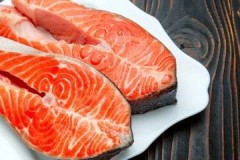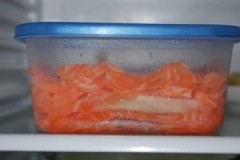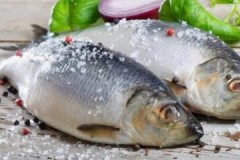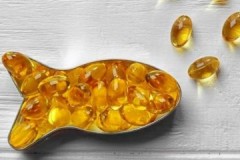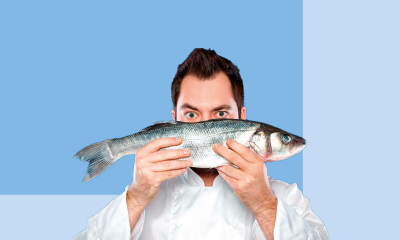 Storing fish is a responsible process. The taste of the product, its consistency, and shelf life depend on it.
Storing fish is a responsible process. The taste of the product, its consistency, and shelf life depend on it.
Storage rules are determined by many factors: the biological type of fish, temperature, method of pre-processing, and characteristics of the container.
Read the article about what conditions must be observed when storing fish, where it will remain fresh longer, which negatively affects its taste and smell and more.
Content
- What are the storage rules?
- What determines the expiration dates?
- How and for how long to store fresh?
- In the freezer
- Where is it better to keep dried and dried at home?
- Salty
- Smoked
- Red
- Live fish and invertebrates for sale
- Canned fish
- Semi-finished products
- Cooked
- How long does it last in vacuum packaging?
- Fish fat
- Which option takes the longest?
- Conclusion
What are the storage rules?
It is important to store fresh fish when refrigerated in the correct packaging. A cellophane bag or cling film is not suitable for this purpose, since there is no access to fresh air, which causes the product to “suffocate,” quickly deteriorate, and acquire an unpleasant odor. It can only be wrapped in polyethylene if it is to be frozen.
 Before storing fish, you need to prepare by following these steps:
Before storing fish, you need to prepare by following these steps:
- separate the carcass from the head - it contains gills, which quickly deteriorate, and putrefactive processes spread to the entire product;
- remove entrails;
- rinse the carcass from the inside and outside;
- remove excess moisture using a paper towel or napkin.
You cannot store fresh fish outside the refrigerator, as its shelf life in such conditions is reduced to several hours.
Temperature
Fresh fish can be stored at different temperatures:
- From 0 to -2 degrees, chilled whole carcasses. The shelf life is 2 days.
- In cut form at a temperature of 0 to -2 degrees – a day.
- In the bag in the refrigerator - no more than 8-12 hours.
- In the freezer, fresh fish will be good for eating from 6 months to a year, depending on its variety.
- Fresh fish can be stored at room temperature for no more than 3 hours, provided it is kept in a cool, well-ventilated area.
What determines the expiration dates?
Shelf life of fish depend on the following factors:
- A method of freezing fish after catching. If it has been exposed to natural cold, the shelf life is reduced. Wet artificial freezing is a priority. With it, the fish is covered with a layer of glaze, which extends its shelf life. Fish subjected to shock freezing at a temperature of -30 degrees is stored even longer.
- Product storage conditions.
- Biological species of fish.
- Fish sizes. Large carcasses are stored refrigerated for up to 12 days, and small ones for no more than 9 days.
- Catch time. If it was mined in winter, then the shelf life increases.
How and for how long to store fresh?
Fresh fish is not only tasty, but also healthy, as it contains the maximum amount of nutrients, vitamins and microelements. However, if stored improperly, they quickly deteriorate, and the meat itself deteriorates.
Therefore, it is so important to observe the conditions for keeping the product in the refrigerator and without it, immediately after catching and not only.
Raw, in the refrigerator
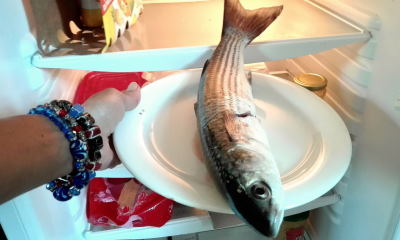 If you plan to store fish on refrigerator shelves, it is cleaned of scales, the entrails are removed, and dried with a napkin and place in a paper bag or wrapped in parchment.
If you plan to store fish on refrigerator shelves, it is cleaned of scales, the entrails are removed, and dried with a napkin and place in a paper bag or wrapped in parchment.
The product can be rinsed under running cool water, but this condition is not mandatory. The main thing is to pack it well so that the fishy smell does not permeate other dishes, and it does not absorb their aromas.
Temperature matters, which is maintained in the refrigerator. If it is in the range of 0...-2 degrees, then the product remains fresh for 3 days.
However, you need to take into account that the actual temperature in the refrigerator is +4...+6 degrees, since its doors are constantly opening, and there are other products and utensils on the shelves. In this case, the storage period should be limited to 24 hours.
Chilled
Cooling fish involves placing it either on a refrigerator shelf or surrounded by crushed ice. It is placed in a suitable container (plastic or glass container) and covered with crushed ice from top to bottom.
Another way to extend the shelf life of chilled fish is to place it in the refrigerator. on a special shelf called the freshness zone. As a rule, this is the lower section where the minimum temperature is maintained.
Natural preservatives help increase the shelf life of fresh carcasses. It can be salt, lemon juice, vegetable oil. These products inhibit the growth of pathogenic flora and improve the taste of the final dish. Read more here.
At room temperature
No refrigeration at room temperature fish can be kept for no more than an hour. After the specified period of time, bacteria begin to multiply in it, although the smell and appearance of the product may remain unchanged.
However, there are ways to extend the shelf life of carcasses, even if it is not possible to place them in the refrigerator and there is no freezer. To do this, you will need a cool room with good air ventilation.
Proceed as follows:
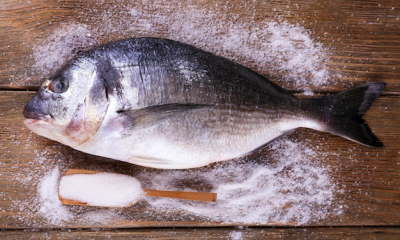 the product is completely cleaned, the head is cut off or the gills are removed, the entrails are removed, and the fins are cut off;
the product is completely cleaned, the head is cut off or the gills are removed, the entrails are removed, and the fins are cut off;- remove excess moisture with a paper towel;
- rub the product with salt and black pepper;
- wrap it in cotton cloth soaked in a special solution - to prepare it you will need 200 ml of vinegar and 2 teaspoons of sugar;
- Place the product in a container and cover with coarse salt.
If all conditions are met, the fish will be suitable for consumption for 3 days.
Is it possible and how to save your catch while fishing?
There are several ways to keep your catch fresh while fishing, even if it is done in the heat:
- Place the fish in the tank, which should be located in a shaded place with constantly updated cool water. Fish in such conditions can live for several days.Periodically, the cage should be checked for dead individuals.
- Bury fish. First, you need to place it in a bag and sprinkle it generously with salt. The place should be shady and damp, for example, sand on the shore of a pond.
- Perform dry salting. To do this, the carcasses are gutted, rubbed with salt inside and out, then wrapped in natural cotton cloth and tied with twine. This method is suitable if the ambient temperature does not exceed 18 degrees.
- Use an aerator. These are special containers into which oxygen is supplied. The fish stay alive in them for a long time.
- Use a cooler bag. The product will remain fresh in it for about 6-12 hours.
Read about storing fresh fish in snow and other places Here, fishing - here.
In the freezer
Frozen fish can be stored for 2 to 12 months. The temperature in the freezer should not be lower than -18 degrees, otherwise the process of spoilage will begin.
Conditions to be followed:
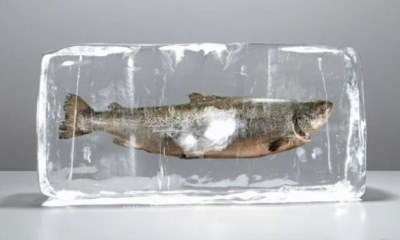 High quality packaging. To insulate carcasses, you can use cling film, vacuum bags, and cellophane.
High quality packaging. To insulate carcasses, you can use cling film, vacuum bags, and cellophane.- Small fish can be frozen in containers, large fish - in individual specimens.
- For long-term storage, it is better to use the bottom shelf of the freezer.
- Do not allow exposed areas of fish to come into contact with other products or frosty air.
The shelf life in the freezer is largely determined by the type of fish. So, for small breeds it is about 2-4 months, and for large breeds it can reach a year. Tells you about the shelf life of frozen fish this article on how long you can store - this.
Freezing methods
There are 3 ways to freeze fish caught:
- in natural conditions - it is used in the cold season, when the air temperature drops below zero by several degrees;
- contact freezing using liquid - in this case the product is covered with a thin glaze;
- blast freezing - carcasses are placed in freezers where the temperature reaches -30 degrees.
Methods for freezing fish are discussed in this article.
How to defrost correctly?
There are several ways to defrost fish:
- Place it on the top shelf of the refrigerator. This method is the longest, but the most correct. This way the fish will not lose its taste and its consistency will not be compromised.
- In water. To do this, the fillets are placed in a bag and placed in a container of a suitable size. The water should be cool. If the whole carcass is being defrosted, then the bag may not be used, but the water will have to be changed every quarter of an hour.
- Under running water. The product must be in a sealed bag.
- In a steamer. Water should not touch the product. Heating is carried out over low heat so that the fish does not cook. As it thaws, turn it over.
- In the microwave. Many microwave ovens have a fish defrosting function. The whole process will take no more than 7 minutes, depending on the size of the carcass. It must be covered with a lid.
Will tell you how to defrost fish correctly this article.
Why does frozen fish fall apart after defrosting?
If after defrosting the fish becomes loose and begins to fall apart, this may be due to the following reasons:
 It was frozen incorrectly at the plant.The temperatures may have been too low. As a result, the water that was inside the fillet crystallized. The crystals disrupted the cell structure.
It was frozen incorrectly at the plant.The temperatures may have been too low. As a result, the water that was inside the fillet crystallized. The crystals disrupted the cell structure.- Improper storage of fish. It can fall apart due to constant temperature changes, as well as when it is re-frozen.
- The fish was defrosted in hot water
- The wrong cooking method was chosen, for example, frying in a cold frying pan using unheated oil.
Read more here.
How to salt frozen?
Ambassador Tips fish after defrosting:
- if the carcass is whole, then there is no need to wait for it to completely thaw, it will be easier to cut and slice it;
- It is better to salt large fish in pieces, which will save time;
- Before salting, the product is defrosted in the refrigerator - it cannot be kept at room temperature or in hot water;
- coarse salt should be used so that it removes excess moisture from the product;
- The product should be placed in a glass or plastic container with a lid;
- Before salting, you need to rinse the fish and dry it with a paper towel;
- Depending on the size, the fish can be salted from 3 hours to 3 days.
Details - in this article.
Where is it better to keep dried and dried at home?
Features of storage of dried and dried fish at home:
- Dried fish should be stored in a cool place with a humidity level of 80%. This could be a storage room or attic. The air temperature should not exceed 10 degrees.
- Carcasses should be sorted depending on size. Small fish can be wrapped in parchment in several pieces, and large fish can be stored individually.
- It is best to hang the fish on hooks. To prevent it from drying out, it is packed in paper.
- To save space, the fins are cut off.
- If you plan to store the product for a long time, then it is placed in the refrigerator. At a temperature of about -5...-8 degrees, it will not deteriorate within six months.
- You can freeze dried fish. In the freezer it will remain edible for a year. After defrosting, it should be dried for 2-3 hours.
Will tell you about storing dried fish this article, dried - this.
Balyk
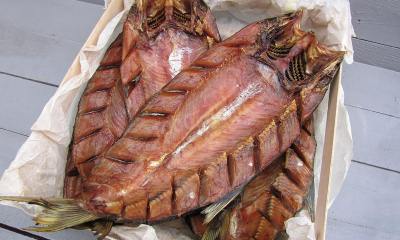 Store fish balyk in the refrigerator. For this sealed packaging is used: container or plastic bag.
Store fish balyk in the refrigerator. For this sealed packaging is used: container or plastic bag.
It should be clean and have a tight-fitting lid. If the temperature in the refrigerator is maintained at +2...+5 degrees, then the balyk will be suitable for eating for about 30 days.
For longer storage, the product is wrapped in a paper towel, placed in an airtight container or vacuum bag and placed in the freezer. There it will remain fresh for about six months. The product cannot be re-frozen. Read more here.
Salty
Salted fish lasts longer than fresh fish, but subject to the following recommendations:
- the product is in the refrigerator - if it is wrapped in parchment, the shelf life is about 5 days;
- carcasses or fillets are placed in vacuum packaging;
- Vegetable oil or brine helps to extend the shelf life - the stronger it is, the longer the product will remain fresh;
- in the freezer, fish should be stored only in paper or cotton cloth; polyethylene should be discarded;
- lightly salted fish remains fit for consumption when stored in the refrigerator for no longer than 3 days;
- In factory vacuum packaging, salted fish can be stored for up to 3 months, but only if it is intact.
Read about storing salted fish at home here, in the freezer - Here.
Red
Storage rules salted red fish:
- In brine it remains fresh for about 7-10 days at a temperature no higher than +2 degrees.
- Without brine, the product is stored in the refrigerator in a plastic bag or cling film for about 3-5 days.
- Store red fish in the freezer cut into pieces. They are dried with a paper towel, transferred to a vacuum or regular bag, the air is expelled from it and closed tightly. Under such conditions, the product will remain fresh for about six months.
- Red fish in vacuum factory packaging can be stored in the refrigerator for about 3 months.
In the freezer
Storage rules salted fish in the freezer:
 Before putting it in the freezer, you must completely drain the brine;
Before putting it in the freezer, you must completely drain the brine;- dry the product by blotting it with paper napkins;
- the carcass is cut into pieces so that it does not have to be defrosted entirely;
- For storage use cling film, a vacuum bag or a plastic container;
- The shelf life of frozen salted fish is six months.
The longer the product is exposed to frosty air, the more moisture it will lose, which affects the final taste and texture of the meat. It is recommended to store herring and mackerel without freezing.
Smoked
Storage Features smoked fish:
- In the refrigerator on the bottom shelf, the hot smoked product remains fresh for no more than 2 days.
- Cold smoked fish is stored in the refrigerator for about 2 weeks at a temperature no higher than +2 degrees.
- Before placing it in the refrigerator, the carcasses should be wrapped in several layers of parchment or foil. This way they won’t “suffocate” and permeate other products with their smell.
- You can leave the fish on the loggia, but provided that the air temperature is from -2 to +2 degrees, and the product is not exposed to direct sunlight. The fish are either hung on a rope or placed in paper bags.
- All entrails should be removed from an uneviscerated product.
- At room temperature, smoked fish can be stored for no longer than 3 hours.
Read about ways to store smoked fish Here And here.
In the freezer
In the freezer, smoked fish will remain edible for about 3 months. It is placed in vacuum bags or wrapped in cling film. You can also use parchment.
Red
Storage Features red fish:
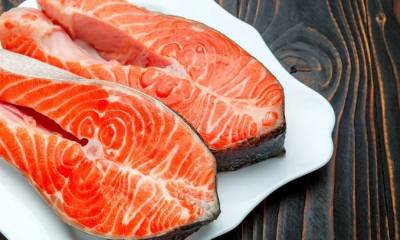 At room temperature, fresh red fish can be stored for no more than 2 hours. After this, the processes of rotting meat begin.
At room temperature, fresh red fish can be stored for no more than 2 hours. After this, the processes of rotting meat begin.- In the refrigerator at a temperature of 0 to -2 degrees, it will be edible for about 8-10 days.
- If red fish is sealed in factory vacuum packaging, then it will last in the refrigerator for 45 to 60 days, but only if it is intact. You should look for exact information on the label.
- Homemade salted red fish remains edible for 2-3 days.
- In the freezer at temperatures below -18 degrees, red fish does not spoil for 3-6 months.However, you can only freeze fresh carcasses that have not previously been defrosted. It is most convenient to do this in portions. For containers, you can use sealed bags, plastic containers or cling film.
- Fresh red fish without packaging can be stored in the refrigerator for 2 days. In this case, the air temperature should not be higher than +3 degrees.
- Heat-treated red fish can be stored in the refrigerator for 2-3 days. It is placed in containers and covered with a lid, or wrapped in parchment (foil).
Read about storing red fish Here And here.
Live fish and invertebrates for sale
Caught and sorted fish placed in cages that are enriched with oxygen. Transportation to the point of sale must be carried out in special containers.
In the store, live fish and invertebrates are stored in aquariums. The water in them must be dechlorinated, maintaining its stable temperature in the range from +3 to +15 degrees. Aquariums should not be exposed to bright light.
It is important to ensure that there are no dead or fungal fish in the aquarium. Live mussels are sold only in places of production. Their shelf life should not exceed 12 hours. Oysters can be stored for no more than 10 days. An important condition is the ambient temperature of 3-5 degrees. Read more here.
Canned fish
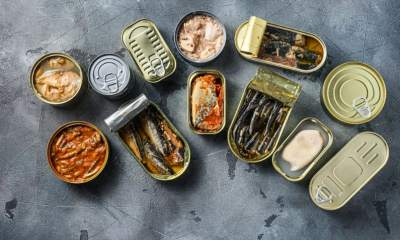 Canned fish is stored in a cool, shaded area.. The product should not be exposed to temperature changes.
Canned fish is stored in a cool, shaded area.. The product should not be exposed to temperature changes.
The optimal mode is considered to be a range of 0...+5 degrees, and air humidity should not exceed 75%. Check the label for information on shelf life.
Damage is indicated by swelling of the lids or bottoms, oxidation of fats, and the appearance of rust on the cans. When properly stored, fish pieces are solid, do not disintegrate into fibers, have a dense consistency and a characteristic odor. Details - in this article.
Semi-finished products
Semi-finished fish products are stored in a refrigerator, the temperature in which should be maintained in the range of 0 ... + 4 degrees. The shelf life of such products is one day., provided that the carcasses are whole.
They are placed in containers, covered with lids and placed on the bottom shelf. To extend the shelf life of the product, it can be salted.
Chopped semi-finished products are kept in the refrigerator for no more than 12 hours. We are talking about products in breadcrumbs, vegetable oil, citric acid, and pepper. Fish coated in flour should not be stored.
Another way to store semi-finished products is in the freezer. The shelf life of fillets under such conditions is 2-3 months, dumplings – 30 days, whole carcasses – up to six months. Details - in this article.
Cooked
Storing cooked fish has the following features:
- The product should not be left at room temperature. Immediately after it cools down, it is put into the refrigerator.
- Opened fish should not be stored. It is a source of odor and also absorbs the aromas of other products.
- The finished product is transferred to containers, glass or enamel containers and covered with a lid. You can also wrap the carcasses in foil or parchment. It is not recommended to store cooked fish in a bag.
- You can extend the shelf life of cooked fish if you put it in the freezer. In this case, you can use cling film or vacuum bags. The shelf life of this product is about 3 months.
- Fish should not be re-frozen, regardless of the method of preparation.
Fried
 Storage rules fried fish:
Storage rules fried fish:
- after frying, the product is cooled and placed in containers or other suitable containers with a lid;
- containers are placed in the freezer;
- the fish is eaten for 2-3 days, provided that it has been chilled all the time at a temperature not higher than +5 degrees.
If you have cooked a lot of fish, you can freeze it. For this purpose, sealed packaging is used. The freezer temperature should be -18 degrees or lower. In this form, the product will be suitable for consumption for about 3 months. Details in this article.
Boiled and baked
Rules for storing boiled and baked food fish:
- Boiled or baked fish can be stored at room temperature for no more than 2 hours.
- It stays fresh in the refrigerator for no longer than 3 days.
- Boiled fish should be left in the broth in which it was cooked. Before eating it, boil it or heat it in the microwave.
- If there is no need for broth, then it is drained and the fish is transferred to a container or pan. Without broth, it should be eaten within 24 hours.
- Baked fish can be stored in the refrigerator in the foil in which it was cooked.This will prevent the product from drying out and extend its shelf life to 2 days. If vegetables were used in cooking, you should not store it for longer than 24 hours.
Details - in this article.
How long does it last in vacuum packaging?
Vacuum packaging eliminates contact of the product with air, thereby extending its shelf life. It can be used for dried, raw, cooked and salted fish.
Exact expiration dates depend on type of fish and selected temperature:
- Fresh fish can be stored in the refrigerator for up to 5 days, and in the freezer for up to a year;
- salted fish in a vacuum can be left in the refrigerator for 40 days, and in the freezer for 90 days;
- After opening the vacuum packaging at temperatures up to +3 degrees, the fish can be stored for about 3 days.
Read more Here.
Fish fat
Rules for storing fish oil:
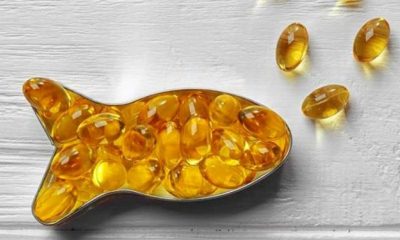 If fish oil is in capsules, its shelf life is 2-3 years. Please check the packaging for exact information. The drug should be kept in a dark place, at a temperature no higher than +25 degrees.
If fish oil is in capsules, its shelf life is 2-3 years. Please check the packaging for exact information. The drug should be kept in a dark place, at a temperature no higher than +25 degrees.- The shelf life of fish oil in a bottle is 1 year. Once the package is opened, it is reduced to 3 months. The container should be opaque, which helps protect the fat from direct sunlight.
- After opening, the bottle is placed in the refrigerator.
Consumption of expired fish oil is unacceptable. It reduces the concentration of nutrients. In addition, there is a risk of complications.Read more Here.
Which option takes the longest?
In order for fish to remain edible for as long as possible, it must be stored in the freezer. Depending on the processing method, size and type of fish, Its shelf life in the freezer ranges from 3 months to a year.
Large fresh carcasses without entrails and heads are stored the longest. They can remain edible for about 10-12 months. Small fish can be stored for up to six months. The use of vacuum bags allows you to increase shelf life.
Conclusion
Fish is a perishable food product. Therefore, it is so important to comply with its storage conditions. First of all, this concerns the temperature regime.
The shelf life of fish differs, which must be taken into account when sending the product to the freezer, refrigerator or other suitable places.
